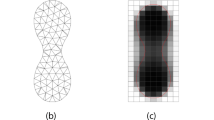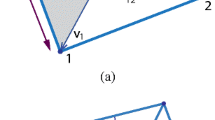Abstract
This paper introduces the 3DNFDM method, which extends the natural force density method (NFDM) to three-dimensional problems. The NFDM was first proposed by Pauletti in 2006, as a method for finding configurations of membranes and funicular shell structures, providing viable equilibrium geometries in a single linear equilibrium analysis (Pauletti, in: Proceedings of the IASS symposium/APCS conference—New Olympics, New Shell and Spacial Structures, Beijing, 2006; Pauletti and Pimenta Comput Methods Appl Mech Eng 197(49):4419–4428, 2008. https://doi.org/10.1016/j.cma.2008.05.017). It is an extension of the force density method (FDM), which was originally proposed by Linkwitz (IASS Pacific symposium on tension structures and space frame, Tokyo, pp 145–158, 1971), Linkwitz and Schek (Ingenieur-Archiv, 40:145–158, 1971. https://doi.org/10.1007/BF005321463) for the shape finding of cable nets and has since become ubiquitous in the field of membrane design. Directly treating the continuous membrane problem, the NFDM overcomes limitations of the original FDM, by dealing with irregular meshes and accurately representing continuous surface stress fields. The 3DNFDM represents a further extension of the FDM to three-dimensional problems, which allows for the exploration of a novel class of shape finding problems, generating relevant viable volumetric shapes. Some of these shapes may not be readily interpreted by common sense, but we believe that the 3DNFDM unveils new possibilities for shape finding, as demonstrated by the elementary problems investigated in this foundational paper.



















Similar content being viewed by others
Data Availability
No datasets were generated or analysed during the current study.
References
Pauletti, R.M.O.: An extension of the force density procedure to membrane structures. In: Proceedings of the IASS Symposium/APCS Conference -New Olympics, New Shell and Spacial Structures, Beijing (2006)
Pauletti, R.M.O., Pimenta, P.M.: The natural force density method for the shape finding of taut structures. Comput. Methods Appl. Mech. Eng. 197(49), 4419–4428 (2008). https://doi.org/10.1016/j.cma.2008.05.017
Linkwitz, K.: New methods for the determination of cutting pattern of prestressed cable nets and their application to the olympic roofs munich. In: IASS Pacific Symposium on Tension Structures and Space Frame, Tokyo, 78,145–158 (1971)
Linkwitz, K., Schek, H.-J.: Einige Bemerkungen zur Berechnung von vorgespannten Seilnetzkonstruktionen. Ingenieur-Archiv 40, 145–158 (1971). https://doi.org/10.1007/BF005321463
Otto, F.: Das Hängende Dach. Gestalt und Struktur. Republished in 1990 by Verlag der Kunst, ISBN-10: 3421029873). Bauwelt Verlag, Berlin (1954)
Otto, F. (ed.): Zugbeanspruchte Konstruktionen. Ullstein Fachverlag Verlag, Vol. 1 (1962) and Vol. 2 (1966). English Translation: Tensile Structures, Vols. 1 and 2, The MIT Press, 1973, ISBN-10: 0262650053. Ullstein Fachverlag Verlag, Berlin (1962)
Otto, F. (ed.): Lufthallenhandbuch - Air Hall Handbook. Bilingual Edition. ISBN-10: 3782820150. Bauwelt Verlag, Berlin (1983)
Linkwitz, K.: Formfinding by the direct approach and pertinent strategies for the conceptual design of prestressed and hanging structures. Int. J. Space Struct. 14(2), 73–87 (1999). https://doi.org/10.1260/0266351991494713
Gründig, L., Moncrieff, E., Singer, P., Ströbel, D.: A history of the principal developments and applications of the force density method in Germany 1970–1999. In: Proceedings of IASS-IACM 2000 Symposium (2016). International Association for Shell and Spatial Structures (IASS)
Schek, H.-J.: The force density method for form finding and computation of general networks. Comput. Methods Appl. Mech. Eng. 3(1), 115–134 (1974). https://doi.org/10.1016/0045-7825(74)90045-0
Llorens, J.I.: Report on the VI International Conference on Textile Composites and Inflatable Structures - STRUCTURAL MEMBRANES 2013. TENSINEWS–The Newsletter of the European Based Network for the Design and Realization of Tensile Structures (26), 6–8 (2014)
Zhou, J., Chen, W., Hu, J., Zhao, B., Zhang, T.: Force finding of cable-strut structures using a symmetry-based method. Arch. Appl. Mech. 89, 1473–1484 (2019). https://doi.org/10.1007/s00419-019-01517-0
Chen, Y., Yan, J., Feng, J.: Nonlinear form-finding of symmetric cable-strut structures using stiffness submatrices associated with full symmetry subspace. Arch. Appl. Mech. 90, 1783–1794 (2020). https://doi.org/10.1007/s00419-020-01696-1
Liew, A.: Constrained force density method optimisation for compression-only shell structures. Structures 28, 1845–1856 (2020). https://doi.org/10.1016/j.istruc.2020.09.078
Trinh, D.T.N., Lee, S., Kang, J., Lee, J.: Force density-informed neural network for prestress design of tensegrity structures with multiple self-stress modes. Eur. J. Mech. A. Solids 94, 104584 (2022). https://doi.org/10.1016/j.euromechsol.2022.104584
Zhao, Z., Yu, D., Zhang, T., Gao, H.: Form-finding and optimization for free form grid structures supported by branching columns based on updated force density method. Structures 44, 1190–1203 (2022). https://doi.org/10.1016/j.istruc.2022.08.063
Zhang, L.-Y., Jiang, J.-H., Wei, K., Yin, X., Xu, G.-K., Zhang, J.: Self-equilibrium and super-stability of rhombic truncated regular tetrahedral and cubic tensegrities using symmetry-adapted force-density matrix method. Int. J. Solids Struct. 233, 111215 (2021). https://doi.org/10.1016/j.ijsolstr.2021.111215
Wang, Y., Xu, X., Luo, Y.: Form-finding of tensegrity structures via rank minimization of force density matrix. Eng. Struct. 227, 111419 (2021). https://doi.org/10.1016/j.engstruct.2020.111419
S̄amec, E., Gidak, P., Fresl, K.: Iterated Ritz and conjugate gradient methods as solvers in constrained form-finding: a comparison. Heliyon 7(5), 07011 (2021). https://doi.org/10.1016/j.heliyon.2021.e07011
Zhang, S., Zhang, S., Zhang, Y., Ye, J.: Force density sensitivity form-finding design method for cable-mesh reflector antennas considering interactive effects between cable network and supporting truss. Eng. Struct. 244, 112722 (2021). https://doi.org/10.1016/j.engstruct.2021.112722
Wang, X., Zhang, J., Cai, J., Feng, J.: An improved energy method for form-finding of mesh reflectors. Arch. Appl. Mech. 92(10), 2795–2812 (2022). https://doi.org/10.1007/s00419-021-02085-y
Marbaniang, A.L., Dutta, S., Ghosh, S.: Updated weight method: an optimisation-based form-finding method of tensile membrane structures. Struct. Multidiscip. Optim. 65(6), 169 (2022)
Zhao, Z., Yu, D., Zhang, T., Cai, Q.: Intelligent design algorithm for branching structures based on updated force density method. J. Build. Eng. 57, 104858 (2022). https://doi.org/10.1016/j.jobe.2022.104858
Oberbichler, T., Bletzinger, K.U.: CAD-integrated form-finding of structural membranes using extended Catmull-Clark subdivision surfaces. Comput. Aided Des. 151, 103360 (2022). https://doi.org/10.1016/j.cad.2022.103360
Li, X., Xue, S., Liu, Y.: A novel form finding method for minimum surface of cable net. J. Build. Eng. 48, 103939 (2022). https://doi.org/10.1016/j.jobe.2021.103939
Marbaniang, A.L., Kabasi, S., Ghosh, S.: Form-finding and determining geodesic seam lines using the updated weight method for tensile membrane structures with strut and anchorage supports. Struct. Multidiscipl. Optimiz. 66, 190 (2023). https://doi.org/10.1007/s00158-023-03645-2
Fan, L., Xu, R., Shi, P., Feng, X., Chen, Y.: Simplified form-finding for tensegrity structures through reference joints of symmetry orbits. Structures 49, 1157–1167 (2023). https://doi.org/10.1016/j.istruc.2023.02.006
Argyris, J.H., Dunne, P.C., Angelopoulos, T., Bichat, B.: Large natural strains and some special difficulties due to non-linearity and incompressibility in finite elements. Comput. Methods Appl. Mech. Eng. 4(2), 219–278 (1974). https://doi.org/10.1016/0045-7825(74)90035-8
Pauletti, R.M.O.: The natural force density method . In: Proceedings of the IABSE-IASS Symposium London 2011 Symposium (2011). IABSE / IASS
Souza, M.S.V., Pauletti, R.M.O.: Parametric design and optimization of shell structures using the natural force density method. Proc. IASS Annual Symp. 2016(8), 1–10 (2016)
Pauletti, R.M.O., Fernandes, F.L.: An outline of the natural force density method and its extension to quadrilateral elements. Int. J. Solids Struct. 185–186, 423–438 (2020). https://doi.org/10.1016/j.ijsolstr.2019.09.003
Souza, M.S.V., Pauletti, R.M.O.: An overview of the natural force density method and its implementation on an efficient parametric computational framework. Curved Layered Struct. 8(1), 47–60 (2021). https://doi.org/10.1515/cls-2021-0005
Lee, K.S., Han, S.E.: Advanced shape finding algorithm of force density method based on FEM. Adv. Steel Constr. 7(4), 313–329 (2011)
Tsiatas, G.C., Katsikadelis, J.T.: Nonlinear analysis of elastic space cable-supported membranes. Eng. Anal. Boundary Elem. 35(10), 1149–1158 (2011). https://doi.org/10.1016/j.enganabound.2011.05.005
Descamps, B., Filomeno Coelho, R., Ney, L., Bouillard, P.: Multicriteria optimization of lightweight bridge structures with a constrained force density method. Comput. Struct. 89(3), 277–284 (2011). https://doi.org/10.1016/j.compstruc.2010.11.010
Gosling, P., Zhang, L.: A linear strain, curvature-driven triangular element for the analysis of membrane structures. Comput. Model. Eng. Sci. (CMES) 83(2), 97–141 (2012)
Veenendaal, D., Block, P.: An overview and comparison of structural form finding methods for general networks. Int. J. Solids Struct. 49(26), 3741–3753 (2012). https://doi.org/10.1016/j.ijsolstr.2012.08.008
Gellin, S., Pauletti, R.M.O.: Necking limits of conoid membrane structures with variable stress ratio. Eng. Struct. 50, 90–95 (2013). https://doi.org/10.1016/j.engstruct.2012.09.023
Tur, M., García, E., Baeza, L., Fuenmayor, F.J.: A 3D absolute nodal coordinate finite element model to compute the initial configuration of a railway catenary. Eng. Struct. 71, 234–243 (2014). https://doi.org/10.1016/j.engstruct.2014.04.015
Yang, C., Shen, Y.-B., Luo, Y.-Z.: An efficient numerical shape analysis for light weight membrane structures. J. Zhejiang Univ., Sci., A 15(4), 255–271 (2014). https://doi.org/10.1631/jzus.A1300245
Greco, L., Impollonia, N., Cuomo, M.: A procedure for the static analysis of cable structures following elastic catenary theory. Int. J. Solids Struct. 51(7), 1521–1533 (2014). https://doi.org/10.1016/j.ijsolstr.2014.01.001
Kmet, S., Mojdis, M.: Time-dependent analysis of cable nets using a modified nonlinear force-density method and creep theory. Comput. Struct. 148, 45–62 (2015). https://doi.org/10.1016/j.compstruc.2014.11.004
Kim, N.-I., Thai, S., Lee, J.: Nonlinear elasto-plastic analysis of slack and taut cable structures. Eng. Comput. 32(4), 615–627 (2016). https://doi.org/10.1007/s00366-016-0440-7
Li, T., Deng, H., Tang, Y.: Mathematical relationship between mean cable tensions and structural parameters of deployable reflectors. Aerosp. Sci. Technol. 56, 205–211 (2016). https://doi.org/10.1016/j.ast.2016.08.003
Xu, R., Li, D., Liu, W., Jiang, J., Liao, Y., Wange, J.: Modified nonlinear force density method for form-finding of membrane SAR antenna. Struct. Eng. Mech. 54(6), 1045–1059 (2015). https://doi.org/10.12989/sem.2015.54.6.1045
Yee, H., Choong, K., Hadi, M.A.: Sustainable development of tensioned fabric green structure in the form of Enneper. Int. J. Mater. Mech. Manufact. 3(2), 125–128 (2015)
Tan, R.P., Pauletti, R.M.O.: A comparison of alternative form finding methods in ixCube 4.10 program. In: IASS 2016 Tokyo Symposium: Spatial Structures in the 21st Century (2016)
Mikula, K., Remešíková, M., Novysedlák, P.: Truss structure design using a length-oriented surface remeshing technique. Discrete Contin. Dyn. Syst. - S 8(5), 933–951 (2015). https://doi.org/10.3934/dcdss.2015.8.933
Li, N., Lu, J., Zong, W., Fan, Y.: Form-finding optimization methods for free-form reticulated shells: reverse realization and numerical simulation. Adv. Mech. Eng. 9(11), 1687814017737256 (2017)
Marmo, F., Rosati, L.: Reformulation and extension of the thrust network analysis. Comput. Struct. 182, 104–118 (2017). https://doi.org/10.1016/j.compstruc.2016.11.016
Tang, Y., Li, T.: Equivalent-force density method as a shape-finding tool for cable-membrane structures. Eng. Struct. 151, 11–19 (2017). https://doi.org/10.1016/j.engstruct.2017.08.010
Veenendaal, D., Bakker, J., Block, P.: Structural design of the flexibly formed, meshreinforced concrete sandwich shell roof of nest hilo. J. Int. Assoc. Shell Spatial Struct. 58(1), 23–38 (2017). https://doi.org/10.20898/j.iass.2017.191.847
Asadi, H., Hariri-Ardebili, M.A., Mirtaheri, M., Zandi, A.P.: Force density ratios of flexible borders to membrane in tension fabric structures. Struct. Eng. Mech. 67(6), 555–563 (2018). https://doi.org/10.12989/sem.2018.67.6.555
Shimoda, M., Yamane, K., Shi, J.-X.: Non-parametric shape optimization method for designing cable net structures in form finding and stiffness maximization problems. Int. J. Solids Struct. 146, 167–179 (2018). https://doi.org/10.1016/j.ijsolstr.2018.03.027
Zienkievicz, O.C., Taylor, R.L.: The Finite Element Method, 4th edn. McGraw-Hill, London (1989)
Bathe, K.-J.: Finite Element Procedures. Prentice Hall, Englewood Cliffs, New Jersey (1996)
Argyris, J.H., Kelsey, S.: Energy Theorems and Structural Analysis. Butterworths, London (1968)
Przemieniecki, J.S.: Theory of Matrix Structural Analysis. MaGraw-Hill, New York (1968)
Funding
This study was financed in part by the Coordenação de Aperfeiçoamento de Pessoal de Nível Superior - Brasil (CAPES) – Finance Code 001.
Author information
Authors and Affiliations
Contributions
RMOP conceived and implemented the new method (3DNFDM), based on his previous research on the NFDM, generated the presented data and wrote the manuscript. VFA reviewed the formulation and developed an independent computer implementation, also based on his own independent research on shape finding problems, which validated the consistency of the new method.
Corresponding author
Ethics declarations
Conflict of interest
The authors declared no potential conflicts of interest with respect to the research, authorship, and/or publication of this article.
Ethical approval
This article does no contain any studies with human participants or animals performed by any of the authors.
Additional information
Publisher's Note
Springer Nature remains neutral with regard to jurisdictional claims in published maps and institutional affiliations.
Rights and permissions
Springer Nature or its licensor (e.g. a society or other partner) holds exclusive rights to this article under a publishing agreement with the author(s) or other rightsholder(s); author self-archiving of the accepted manuscript version of this article is solely governed by the terms of such publishing agreement and applicable law.
About this article
Cite this article
Pauletti, R.M.O., Arcaro, V.F. An extension of the natural force density method to 3D problems. Arch Appl Mech (2024). https://doi.org/10.1007/s00419-024-02580-y
Received:
Accepted:
Published:
DOI: https://doi.org/10.1007/s00419-024-02580-y




